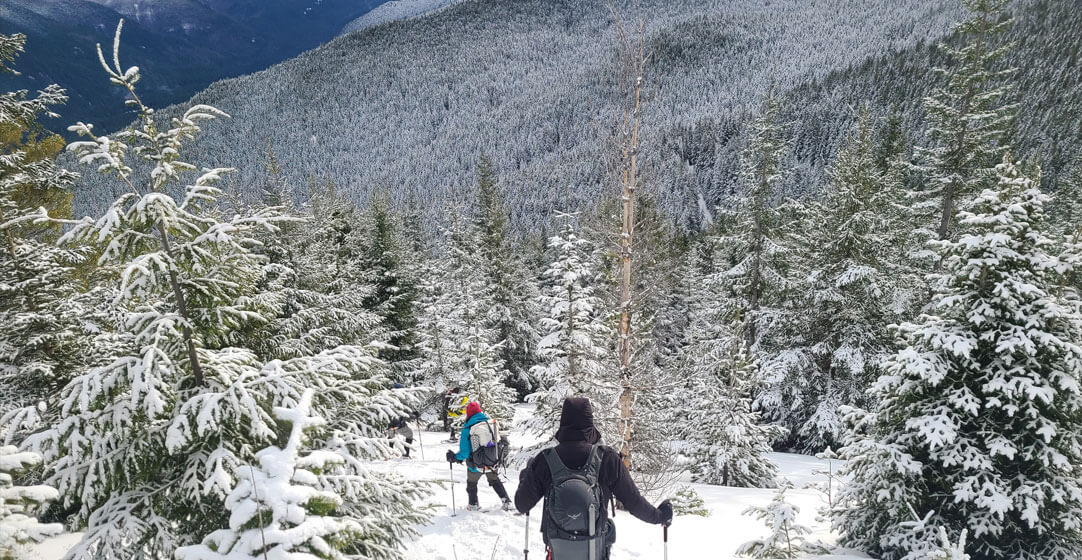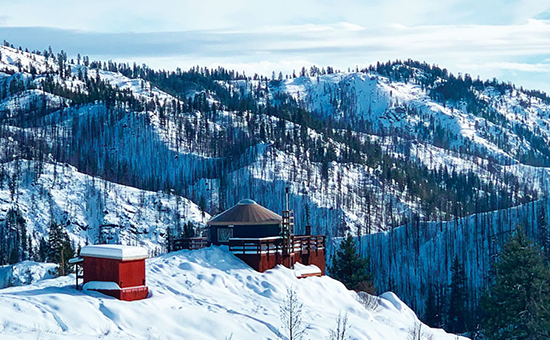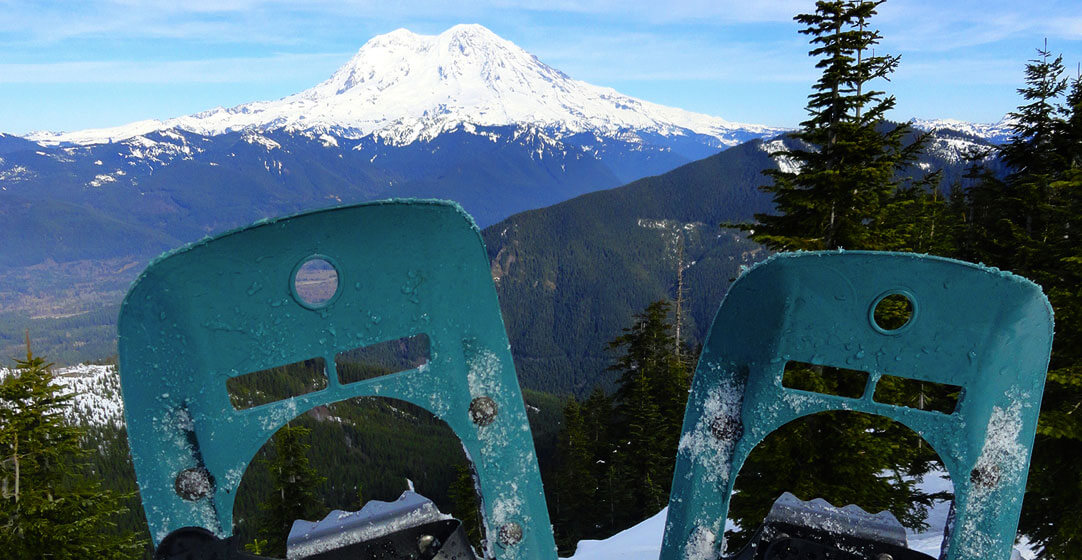Top Snowshoeing Mountains and Trails in Washington and Oregon
From groomed trails to backcountry adventure, experience the magic of snowshoeing in the Pacific Northwest.
Hearing only the crunch of steps and occasional whistle of the wind, Mike Mahanay trudges through a forest of subalpine firs and mountain hemlocks with their limbs blanketed in snow.
About a mile in, the path leads to a sweeping view of the white-capped Mount Rainier. Although the Seattle resident and Washington Alpine Club member of 20 years has seen the mountain numerous times, the stunning vista never disappoints. But it’s the peacefulness of the excursion that sticks with him.
“The stillness and the quietness are just completely remarkable,” Mahanay says. “You’re changing your reality from the city with its news cycle, people honking at you and running stop signs. You get up there, and you’re in the perfect wilderness. … The snow silences everything.”

Natural Wonders
Enjoying the region’s natural beauty isn’t something that has to stop when temperatures drop and snow flurries fall. Much like Mahanay does on his favorite trails leaving from Paradise in Mount Rainier National Park, winter brings an opportunity to rediscover our favorite natural attractions in a new and wondrous way: on snowshoes.
With the allure of walking over a frozen lake or seeing a waterfall framed by a snowy backdrop, snowshoeing is the ultimate winter outdoor activity that anyone can enjoy.
“We’re super lucky to live in the Pacific Northwest where we have all of this unimaginable beauty that we can access in an hour or a few hours from our homes,” Mahanay says.
Many avid snowshoers will tell you: If you can hike, you can snowshoe. It’s similar to hiking in that aside from learning a few basic techniques, the activity doesn’t require any special skills. Renting snowshoes is affordable, so trying it out for the first time isn’t an expensive undertaking.
“It’s like anything new, you always think it’s going to be worse than it is,” says Jim Elliott, who leads free tours for the nonprofit group Discover Your Forest in Oregon’s Mount Bachelor area. “For a lot of folks, they only hike in the summertime. But if you carry the same kind of equipment, put on a little warmer clothing, then you can hike all year round.”
Winter Hiking
Snowshoes, which date to around 4,000 B.C., are designed to disperse a person’s weight, so even if you sink in a few inches, you can walk more easily on top of the snow piling up at higher elevations. Elliott says that when leading a group of newcomers, there’s almost always someone who thinks walking in boots is easier and takes their snowshoes off.
“We have probably 10 to 12 feet of snow. They end up with snow up to the waist and we have to help them get out,” he says.
Snowshoeing trails aren’t as busy in the winter as hiking trails are in the summer, Elliott says, so there’s a better chance of finding solitude. As part of the tour program, Elliott takes groups into the Deschutes National Forest in Central Oregon.
This is home to some of the region’s favorite spots for snow sports, including the shield volcano Tumalo Mountain northeast of Mount Bachelor and Dutchman Flat Sno-Park near Bend, Oregon. Snowshoers will sometimes come across rabbits, squirrels and birds along the way.
“People are surprised by how much life there is,” Elliott says. “Nature is 24 hours a day, 365 days a year. Instead of sitting in your house swearing at the snow, you can get out and enjoy it.”

Off the Snowshoed Path
Even though snowshoes make winter hiking more doable, it is easiest to walk on groomed paths of packed snow. A good place to find these trails is near ski resorts, such as Stevens Pass, Snoqualmie Pass, Mount Baker and Mount Spokane in Washington; Mount Hood, Mount Bachelor and Mount Ashland in Oregon and areas around the Sawtooth Mountains in Idaho.
But even if it doesn’t have a ski lift shuttling people to the top, many Pacific Northwest treasured forests and peaks have nearby groomed trails primed for an adventure in the snowy wonderland. That includes Mount St. Helens and Crater Lake.
One way to elevate your snowshoeing experience is by ending your wintry walk at an overnight destination. Aiming to reach a campsite or one of the cabins that exist along the trails is a fun way to carry a snowshoeing adventure into a second day.
Mount Tahoma Trails of Mount Rainier rents out four backcountry huts for overnight stays, and Alpine Lakes High Camp near Leavenworth has nine remote huts. An area with a handful of Park N Ski areas northeast of Boise, Idaho is home to a series of yurts that can be rented out for the night.
“It’s really cool, this whole area was built out for winter use,” says Tom Helmer, non-motorized trail manager for Idaho State Parks & Recreation. “They all have beds, a stove, a kitchen setup, not to mention great views.”

Backcountry Snowshoeing
For those looking for a challenge or a way to avoid the crowds of sno-parks, there is another way to take snowshoeing to the next level. For KD Dase, who leads backcountry snowshoeing excursions for the Washington outdoor nonprofit The Mountaineers, that is backcountry snowshoeing.
“It snows almost everywhere, so for me the fun part is navigating and making your own way to wherever you want to go,” Dase says. “The downside is you have to look at snow conditions and be careful where you walk.”
Backcountry snowshoeing should be approached with more caution. Dase recommends that even experienced snowshoers should first go with someone who has done backcountry hikes previously as a way to get your bearings.
Along with the extra mental preparation — which includes looking at the forecast from the Northwest Avalanche Center — backcountry snowshoeing is more physical work. In fresh, untouched powder, snowshoes sink a few inches farther than on groomed trails, meaning more work for your legs. But all of it, Dase says, is worth it.
“That remote feeling and those scenic views give you a wonderful feeling,” he says.
–Top photo is Union Peak near Stevens Pass from KD









